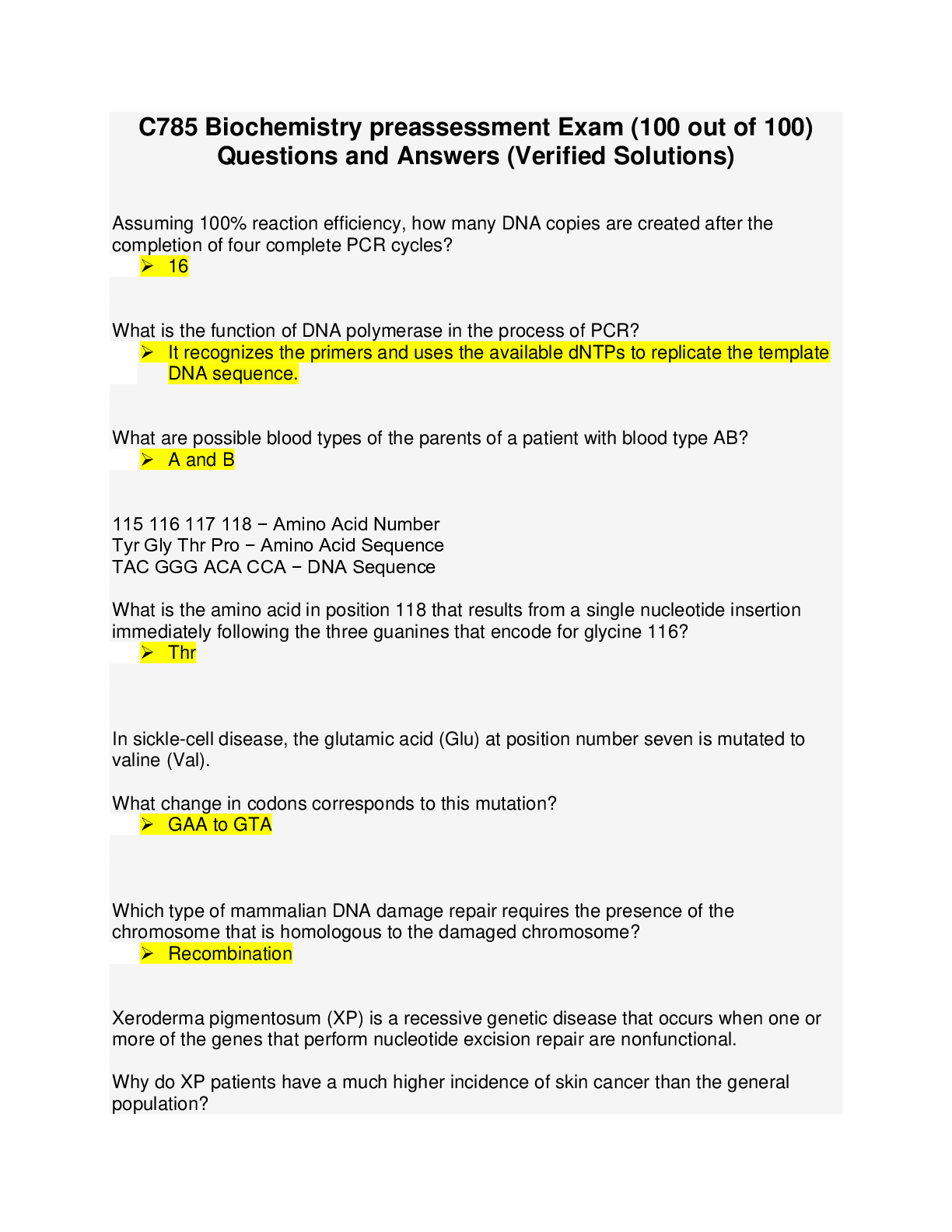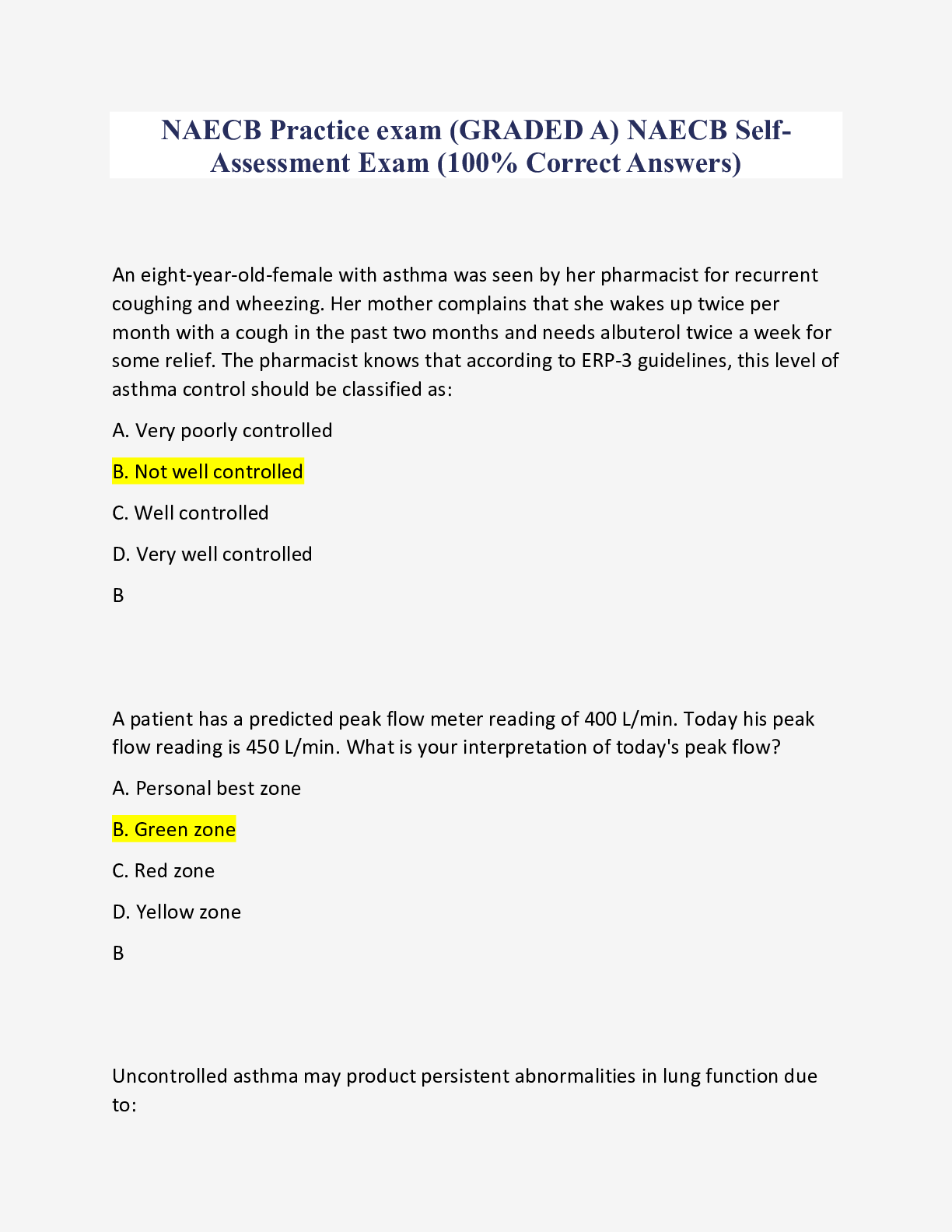Health Care > EXAM > CCRP Patient Assessment Exam (100% Correct Answers) (All)
CCRP Patient Assessment Exam (100% Correct Answers)
Document Content and Description Below
Assessment an objective evaluation or appraisal of an individual's health status, including acute and chronic conditions How does an assessment gather information? through collection of data,... observation, and physical examination What type of assessment? •Gather information about the patient from available sources such as medical records or reports from diagnostic studies • Perform direct measurements on the patient such as 12-lead EKG, blood pressure, or body mass index objective assessment What type of assessment? • Conduct standardized tests, such as a 12-lead EKG or a 6 minute walk test • Observe patient responses or reactions such as cardiac rhythms on telemetry, oxygen saturation on pulse oximetry objective assessment In what type of assessment does the patient provides the information, usually as solicited Subjective assessment What type of assessment does the patient? • Describing their cardiac event • Rating their level of pain or exertion Subjective assessment What type of assessment does the patient? • Reporting on recent behavior, eg, diet, smoking, exercise • Evaluating their own status by completing surveys Subjective assessment At the time of program entrance and exit, all patients should undergo or have the following current screening and assessments: • Current medical history - medical or surgical profile (or both), including complications, comorbidities, and other pertinent medical history • Physical examination - cardiopulmonary systems assessment and musculoskeletal assessment, particularly upper and lower extremities and lower back • Resting 12-lead electrocardiogram • Current medications, including dose and frequency • Cardiovascular disease (CvD) risk profile The goal of __________ is to determine the care, treatment, and services that will meet the patient's initial and continuing needs. Identifying and delivering the right care, treatment, and services depends on the following three processes . . . assessment 1. Collecting information about the patient's health history as well as physical, functional, and psychosocial status 2. Analyzing the information in order to understand the patient's needs for care, treatment, and services 3. Making care, treatment, and services decisions based on the analysis of information collected Individualized case management is an integrated disease-management process that provides specific risk factor intervention strategies. The patient is the center of the process and takes an active role. Initial assessment has several purposes, name four: •Confirm referral diagnosis - it is not enough for a health care provider to scribble a diagnosis on a prescription pad or to type it onto an electronic referral sheet; that diagnosis must be confirmed by an official medical document to justify patient enrollment in rehab and subsequent payment for services rendered • Collect baseline data - each patient's starting point is verified through a series of facts and figures about their status • Begin risk stratification - information gleaned from activities comprising this first encounter may provide clues to the likelihood of a recurrent cardiac event • Build rapport with the patient - spending time with and showing a caring attitude toward a new patient sets the stage for all staff: patient encounters that follow during rehab "Stable" HF is further defined as not having a recent (within last 6 weeks) cardiovascular hospitalization or a planned cardiovascular procedure (within the last 6 months) New York Heart Association criteria for heart failure that qualifies for cardiac rehab. New York Heart Association class II through IV despite being on optimal heart failure therapy for at least 6 weeks Name Six Elements of the Assessment: 1. Event/Medical history 2. First Patient appointment/initial Encounter 3. admission interview/Patient history 4. Cardiovascular Exam 5. EKG and Cardiac Rhythm Strips 6. Body size and strength measurements What should be included in the cardiovascular vital signs? temperature, pulse, and respiration rate are standard; blood pressureshould be taken in both arms and in 2 positions, upright and supine; oxygen saturation via pulse oximetry is also recommended, especially in patients with history of CHF or COPD Name examples of the strength assessment for upper extremities and lower extremities for upper extremities, a simple bilateral hand grip performance may be sufficient to know if strength is the same in both arms; for lower extremities, a timed up-and-go test (TUG), especially in elderly patients, may reveal if leg strength is adequate for basic activities of daily living or if the patient has balance issues that may benefit from some basic physical therapy that may be helpful before proceeding with cardiac rehab exercise training. Name specific pain assessments that should be completed during the initial assessment for baselines Chest pain, leg pain, incision pain, muscle or joint pain individualized treatment plan lists the problems/needs identified to be addressed during rehab. Name three reasons to do a pre-exercise check • Confirm that the patient is stable enough to proceed with this planned exercise session • Rule out a change in the patient's medical condition that would require further medical evaluation before proceeding • Discover additional problems/needs that may need to be added to the patient's ITP for further rehab follow-up How often does a cardiac arrest occur in cardiac rehab? Statistics over several decades of rehab research show that cardiac arrest occurs once in approximately every 100,000 hours of patient exercise Common types of medical emergencies that happen in cardiac rehab and programs should have plans for. . . • Cardiopulmonary arrest • Tachycardia/bradycardia and other changes in cardiac rhythm • Acute chest pain • Acute dyspnea • Hypertension and hypotension • Hyperglycemia and hypoglycemia What is an untoward event? a significant change in a patient's condition Name the criteria of an untoward event? 1. A new or significantly different presentation of a sign or symptom 2. An objective measurement that exceeds the programs established acceptable values What stops a patient's rehab in its tracks and the patient may not resume exercise participation unless/until cleared by the physician in writing. untoward event [Show More]
Last updated: 8 months ago
Preview 1 out of 6 pages

Buy this document to get the full access instantly
Instant Download Access after purchase
Add to cartInstant download
We Accept:

Also available in bundle (1)

CCRP AACVPR TESTS COMPILATION PACKAGE DEAL (100% Correct Solutions)
CCRP AACVPR TESTS COMPILATION PACKAGE DEAL (100% Correct Solutions)
By Goodluck Academia 8 months ago
$20.5
13
Reviews( 0 )
$10.00
Document information
Connected school, study & course
About the document
Uploaded On
Oct 03, 2023
Number of pages
6
Written in
Additional information
This document has been written for:
Uploaded
Oct 03, 2023
Downloads
0
Views
71






.png)










